Nowadays, there seems to be an endless supply of unique-looking chicken breeds with various bizarre traits, from unusual comb shapes to silky-soft feathers and even extra toes!
But one of the most popular traits many hobby farmers love is the densely feathered legs and feet present in the 10 breeds listed below.
All of the breeds of chickens mentioned here almost look as if they’re wearing fancy, feathered shoes, and we love them for it!
Table of Contents
ToggleCochin
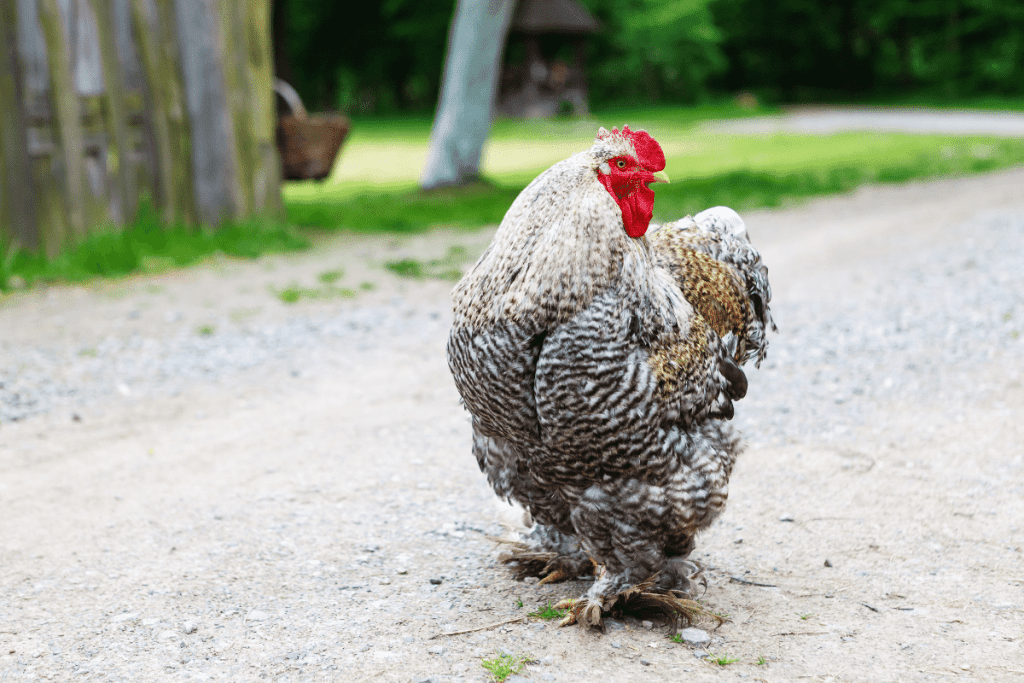
One of the most well-known feather-legged breeds globally is the lovable Cochin, a Chinese breed initially known as the “Shanghai chicken.”
Large, hardy, fluffy, and friendly, there’s a lot to love about Cochins, and they’re available in around a dozen fun colors and both a standard-sized and a much smaller bantam variety.
The Cochin originated sometime in the early 1800s in China.
It quickly became trendy for its large size, densely feathered legs, and dual-purpose nature.
The breed quickly made its way to Europe and much of the Americas by the 1840s.
They were so well-loved; they were later one of the breeds that triggered the widespread “hen fever” phenomenon in the US.
This trend jumpstarted the hobby of keeping backyard chickens for meat and eggs and as pets and beloved companions.
By 1874, Cochins were included in the American Poultry Association’s first edition of their Standard of Excellence.
This publication establishes standard traits for not only chicken breeds but also ducks, geese, and turkeys.
Cochins are useful for their eggs and meat, but they are most commonly kept as a show breed.
They lay huge eggs, even in the colder months.
Cochins are also known for being highly broody, making them good sitters, layers, and mothers.
They’re an all-around excellent, mild-mannered, and useful breed for any flock, especially if you’re a big fan of their handsomely feathered feet and legs!
Take a look at some exhibition chicken breeds to expand your flock.
Silkie

Next, we have the wildly popular Silkie breed, a chicken primarily known for its soft, downy feathers and greyish-blue to black skin.
Silkies are truly bizarre birds, but they are remarkably calm and friendly despite their strange, almost otherworldly appearance.
They’re also highly broody, meaning they will gladly mother their chicks and the orphaned babies of other birds!
This Chinese breed is prevalent in the exhibition scene, but they are also very useful as layers and are sometimes even raised for their oddly grey-colored meat.
Their history is complicated and poorly documented, but they’ve likely existed since the 1200s when explorer Marco Polo initially mentioned encountering “furry chickens” in his travel journals.
The Silkie’s body is covered head to toe in long, soft, downy feathers.
Lacking connective barbicels, the feathers give the birds excellent insulation against the elements.
This makes Silkies incredibly hardy in cold weather, though their feet are at an increased risk of developing frostbite and infection if they become very wet or dirty.
Additionally, Silkies cannot fly or glide like most chickens due to their unusual feather structure.
Though originally, Silkies were a somewhat niche breed, they have become highly well-loved by hobby farmers in more recent years.
As far as chicken breeds with feathered legs go, you won’t find any nearly as soft and cuddly as this one!
Booted Bantam
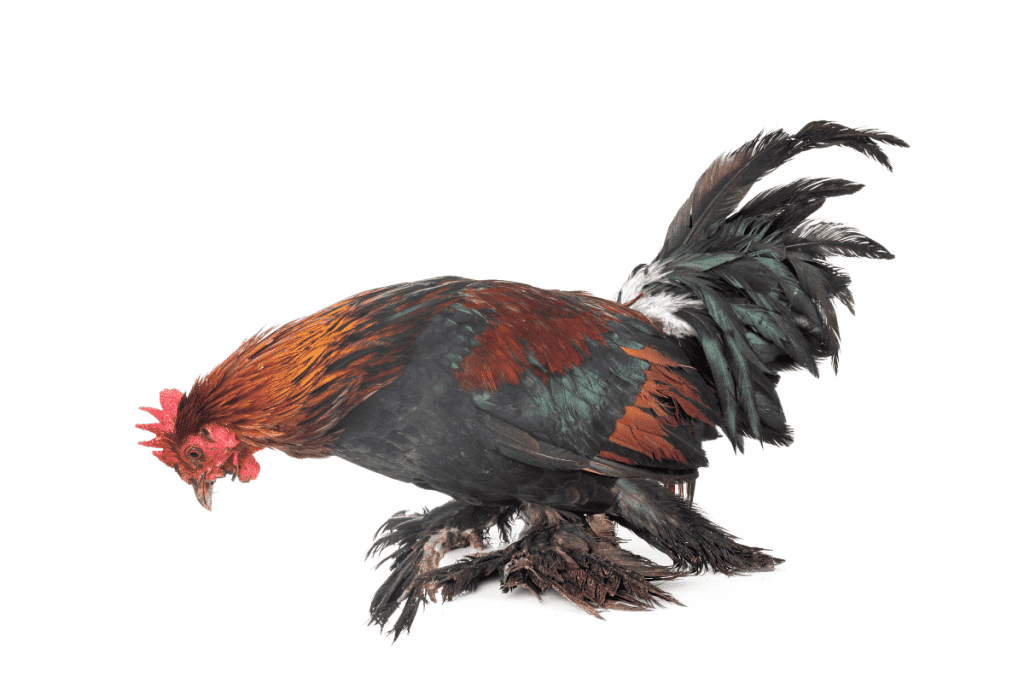
The Dutch booted bantam is a true bantam breed, meaning it doesn’t exist in a standard-sized version.
If you have limited space to work with for your flock but still want to fill it with as many unique birds as possible, these small, lightweight chickens are an excellent addition.
The breed’s Dutch name is “Sabelpoot,” or “saber-legged,” which is a nod to the long, saber-like feathers, commonly known as vulture hocks, on the backs of the bird’s legs.
Its more common name, “booted bantam,” refers to the dense feathering around these tiny chickens’ feet, making them appear like they’re always wearing fancy boots!
Today, booted bantams exist in more than 30 different plumage color varieties and patterns, though only a few colors existed when the breed was first developed in the 1600s.
This breed’s history isn’t very well recorded, but it’s been documented sporadically in European art and literature for at least a few hundred years.
Though their history in Europe is rich, the booted bantam didn’t make it to the US until the 1830s, when they were first bred in Massachusetts.
Their eggs are small and produce very little meat, but they’re now commonly kept as show birds and pets for their unique appearance and friendly, curious nature.
Also read: Are Booted Bantams Noisy And Loud?
Sultan
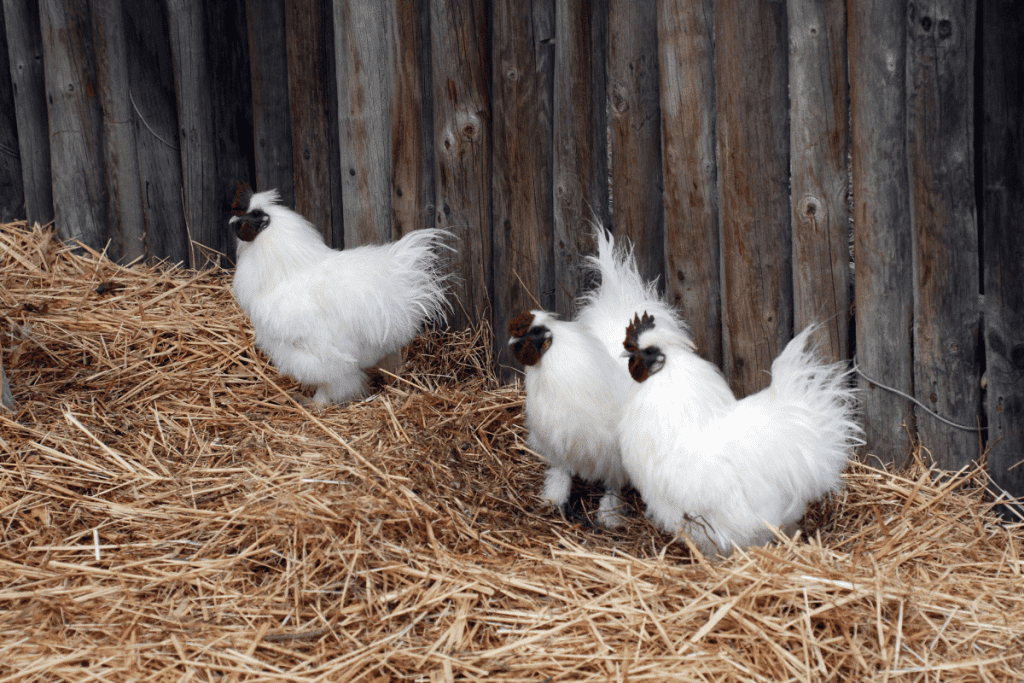
The Sultan’s name suits it well, as atop each bird’s head is a round, fluffy crest resembling a turban or headdress!
Their heavily feathered legs complement their crests and V-shaped combs beautifully, making these ornamental chickens look like they’re always dressed for an elaborate ceremony.
The Sultan chicken is a wonderful option if you want to add a more unusual bird to your flock.
Interestingly enough, the birds were also kept by actual Ottoman sultans as pets as far back as the 1400s.
However, they didn’t leave Turkey until the 1800s, when a British woman living in London brought a small flock of her own back home in 1854.
Sultans quickly became popular in the UK and soon made their way to the United States by the 1870s.
Sultan chickens have an array of strange traits, from their strange plumage to their tendency to be polydactyl and have extra toes on their feet.
They’re relatively small birds, though they also exist in a smaller bantam variety, making them great for smaller flocks with limited space.
Like Silkies, their beautifully feathered feet are prone to frostbite and infection if they become especially wet or dirty.
This means they require special attention for their care and housing, but we think it’s well worth the effort for such a handsome and unique bird!
Further Reading: Sultan Chicken Diet Guide
Pekin
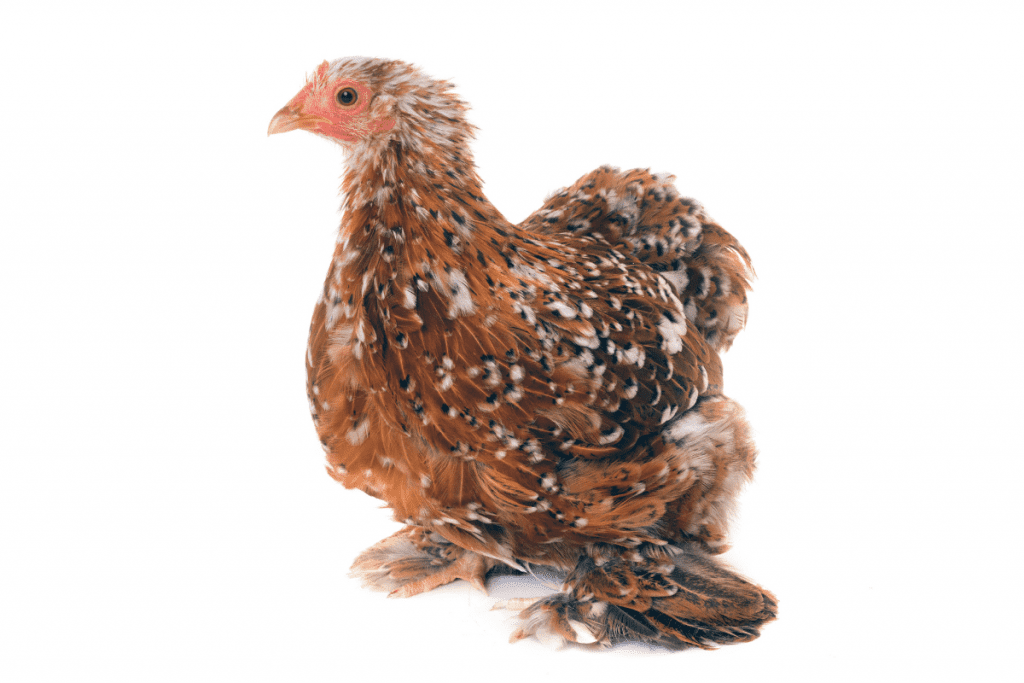
This attractive feather-legged breed is another true bantam, meaning it’s reasonably small and has no standard-sized equivalent.
Pekin chickens are small with round, fluffy bodies and an oddly forward-tilted posture, giving them a cute and miniature appearance.
They are closely related to the Cochin breed and are even referred to as Cochin bantams in the Americas.
The original Pekins were buff in color, but they now exist in various colors and patterns, from standard solid reds, browns, and blacks to more ornate varieties like mottled, partridge, cuckoo, and lavender.
Though now generally seen as a British breed, Pekin is believed to have originated in Peking, China, and didn’t even make it to the UK until the 1800s.
There are various theories about their origin and how they arrived in Britain.
Still, they were likely either stolen from the Emperor of China’s personal flock around 1860 or gifted to Queen Victoria in 1835.
Like most breeds with feathered legs and feet, Pekin chickens require extra care and attention to ensure their feet don’t develop infections or frostbite when they become wet or dirty.
Aside from this, they are very low-maintenance birds with docile, friendly temperaments.
Though they aren’t great layers and produce tiny eggs, Pekin hens are very broody and excellent mothers.
Related: When do Pekin Chickens Start Laying Eggs?
Faverolles
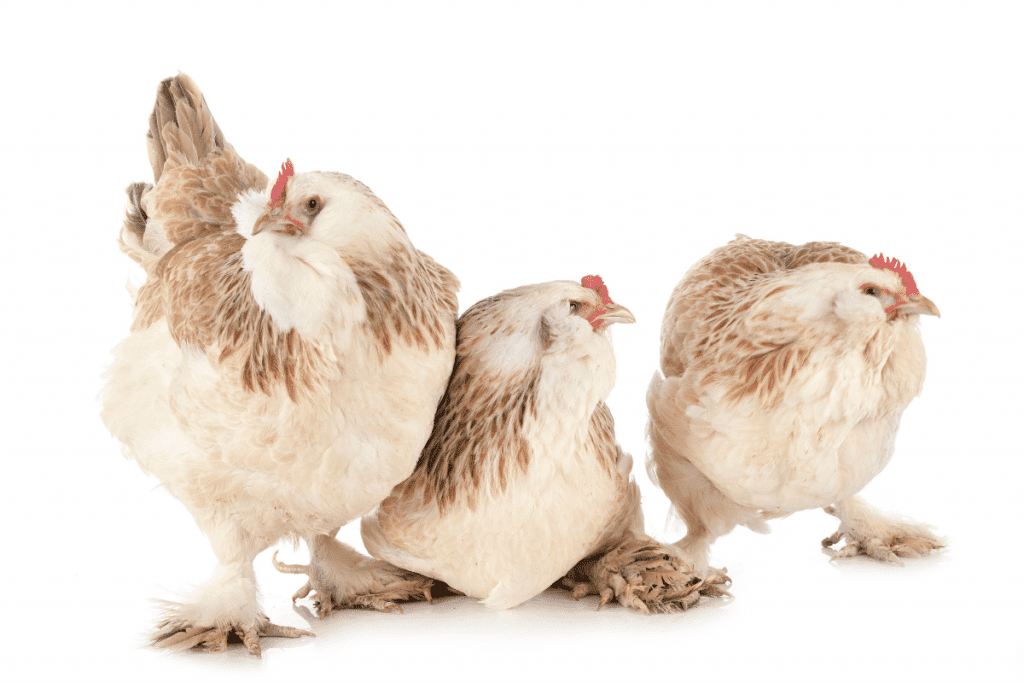
This French breed was first developed sometime in the 1860s in northern France near the village of Faverolles (and the nearby village of Houdan, where the Houdan breed was developed!).
These large, heavy-bodied birds have a delightfully fluffy appearance thanks to their full beards, muffs, and densely feathered feet.
Though they now exist in many colors, the light, pinkish-orange, and white Salmon varieties are the most popular.
Highly adaptable and docile, the Faverolles is one of the hardier breeds on this list, especially for a feather-legged bird.
It’s also one of the friendliest and gentlest chicken breeds around, with even most roosters being surprisingly calm, quiet, and easygoing.
This makes them popular with novice hobby farmers, especially those with children, as Faverolles tolerate handling extremely well and even seem to enjoy being held and petted.
Originally, Faverolles chickens were kept in France mainly for their large, tasty eggs, but they are also very useful as a meat breed, making them an excellent dual-purpose bird.
They’re excellent layers and sitters, and they get along well with almost all other breeds.
At a whopping 8 to 10 pounds, these big birds are gentle giants, and their feathered legs and feet are just one of many of the breed’s attractive traits.
Brahma
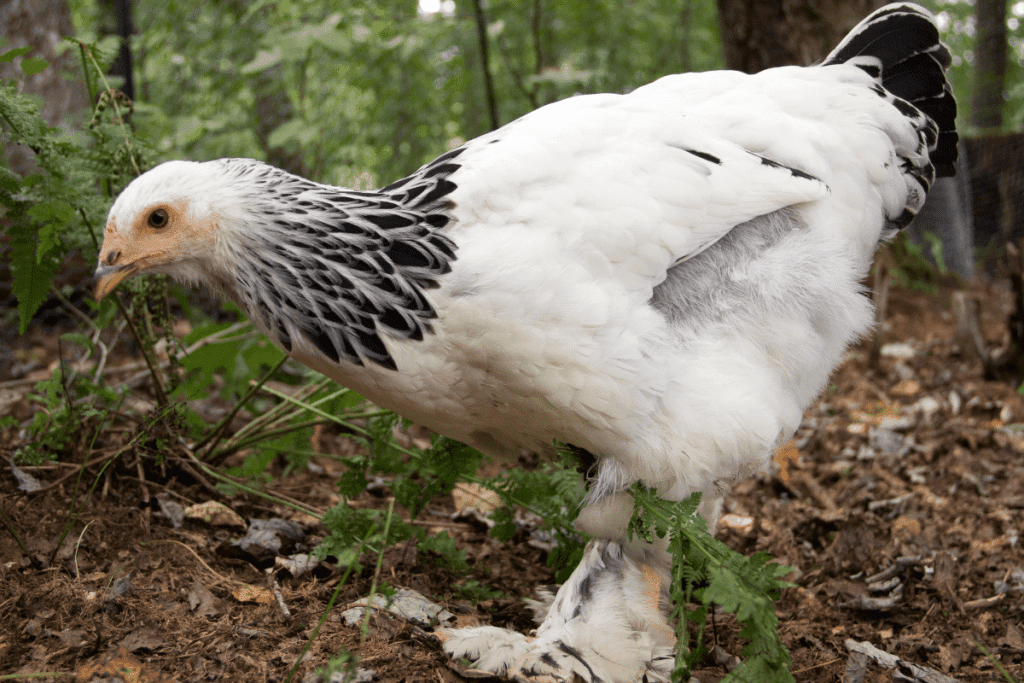
The Brahma is an American breed, but it was developed with the help of birds imported from Shanghai, China, in the 1840s.
These larger birds are hardy, friendly, and handsome, with heavily feathered feet and legs.
They were mainly kept and raised as meat birds, but they later became a popular dual-purpose breed and pet for their exceptional laying ability.
Brahma chickens exist only in light, buff, and dark colors.
The birds have a lighter base body color and darker accents around the hackles and tail feathers.
The feathering around their legs and feet matches their primary body color.
Males are slightly larger than females, as with most breeds, but both sexes are very large, usually weighing around 10 to 13 pounds.
Before 1852, Brahma chickens were simply referred to as “Shanghai chickens,” similar to the Cochin mentioned above, though in 1852, a group of poultry judges changed its official name to “Brahmapootra.”
Eventually, the name became shortened to just “Brahma.”
If you love the Brahma’s appearance yet aren’t sure about owning such a large bird, why not consider bringing home a few bantams instead?
The Brahma bantam is much smaller, lighter, and rounder, weighing only about 2 pounds.
However, it still closely resembles the standard-sized variety in general appearance, fluffy plumage, and temperament.
Both varieties are jolly, confident, and docile chickens with handsomely feathered legs and feet.
This breed is also on our list of hot-weather chickens.
Barbu d’Uccle

The Barbu d’Uccle, also known as the Belgian d’Uccle, is another adorably tiny true bantam breed with feathered legs and feet.
Both roosters and hens are typically under 2 pounds and are only around 5″ inches tall!
Their tiny size makes their comparatively large, feathered feet one of their most prominent traits.
As you’ve probably guessed, the Barbu is native to Belgium and was developed in the early 1900s, making it a somewhat newer breed.
Though its exact origin isn’t sure, it is theorized that the breed was created via the crossbreeding of the Sabelpoot (AKA the Dutch booted bantam) and the Barbu d’Anvers varieties.
It was first only available in three color variations, but by 1909, several others were developed, such as cuckoo and mottled.
Eventually, the Barbu d’Uccle made its way to the UK by 1911, where it quickly became a popular show breed and soon spread to the US and, later, other parts of the world.
Aside from its feathered legs, the breed is also known and loved for its feathered beard and muff.
Both hens and roosters have a reasonably small, single-shaped comb.
Size standards vary by country and organization, but the birds are uniformly small and short with a low, almost backward-leaning posture.
French Maran
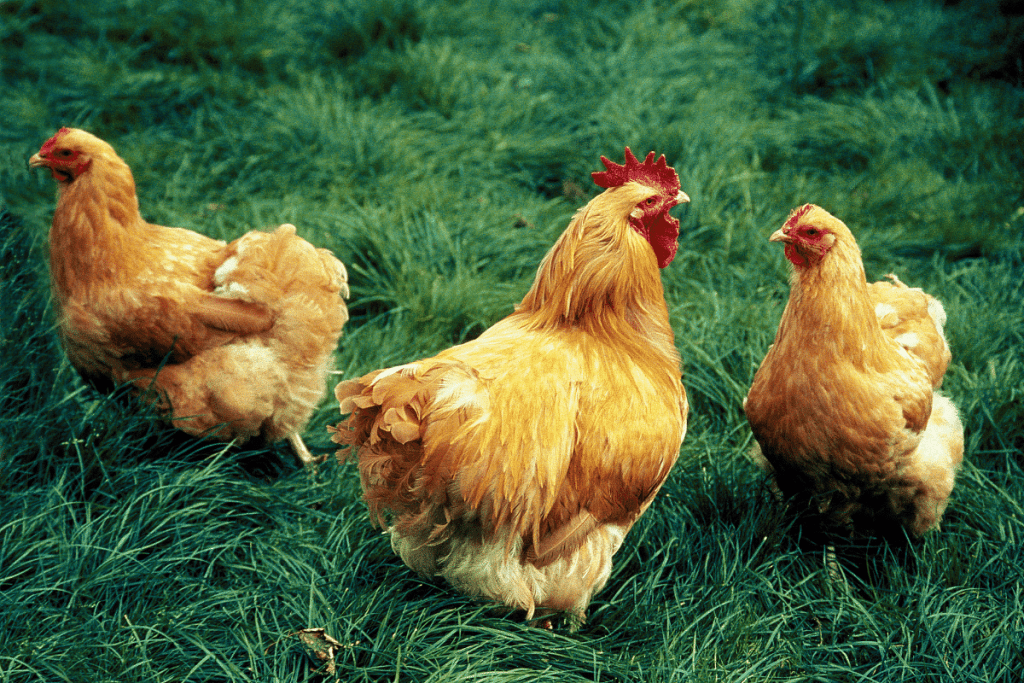
Also known as the Poule de Marans, this breed originated in southwestern France.
Their history isn’t very well recorded, but they were eventually exported to the UK by the 1930s, where they became more popular as a uniquely dual-purpose breed.
French Marans usually have feathered legs, but a clean-legged variety also exists and is recognized by most poultry standard associations.
However, many associations only recognize the feather-legged variety of French Marans birds and do not acknowledge clean-legged chickens as part of the breed standard.
Originally, this breed was developed by breeding local wild chickens with fighting birds brought over from India and Indonesia.
Over time, more than 10 colors were developed, from the typical solid black, white, and silver to more elaborate varieties like cuckoo and wheaten.
In addition to their feathered legs, French Marans chickens are also known for their large, rich, dark brown eggs and high-quality meat.
They are an exceedingly rare tri-purpose breed, as they are also often seen at poultry exhibitions as show birds.
Croad Langshan

Finally, we come to the last uniquely feather-footed chickens on our list: the Croad Langshan breed!
These large, heavy-bodied chickens were originally developed in China, though the exact region in which they were developed is still unknown.
They were, however, eventually imported into the UK in 1872 and the US soon after in 1878.
This breed is likely one of the lesser-known on this list, but they’re slowly gaining more popularity as an egg-laying breed.
This is thanks to Croad Langshans being somewhat large birds, weighing in at around 7 to 10 pounds, with hens being slightly smaller and lighter than roosters.
They exist in three main color variants: black, white, and blue.
These chickens exist in various countries and are highly adaptable, docile birds.
The feathers on the Croad Langshan’s legs are less dense and numerous than those of some of the other chicken breeds on this list, which is convenient if you don’t want to be worrying about your birds developing foot rot or frostbite in their toes!
How useful was this post?
Click on a star to rate it!
We are sorry that this post was not useful for you!
Let us improve this post!
Tell us how we can improve this post?
